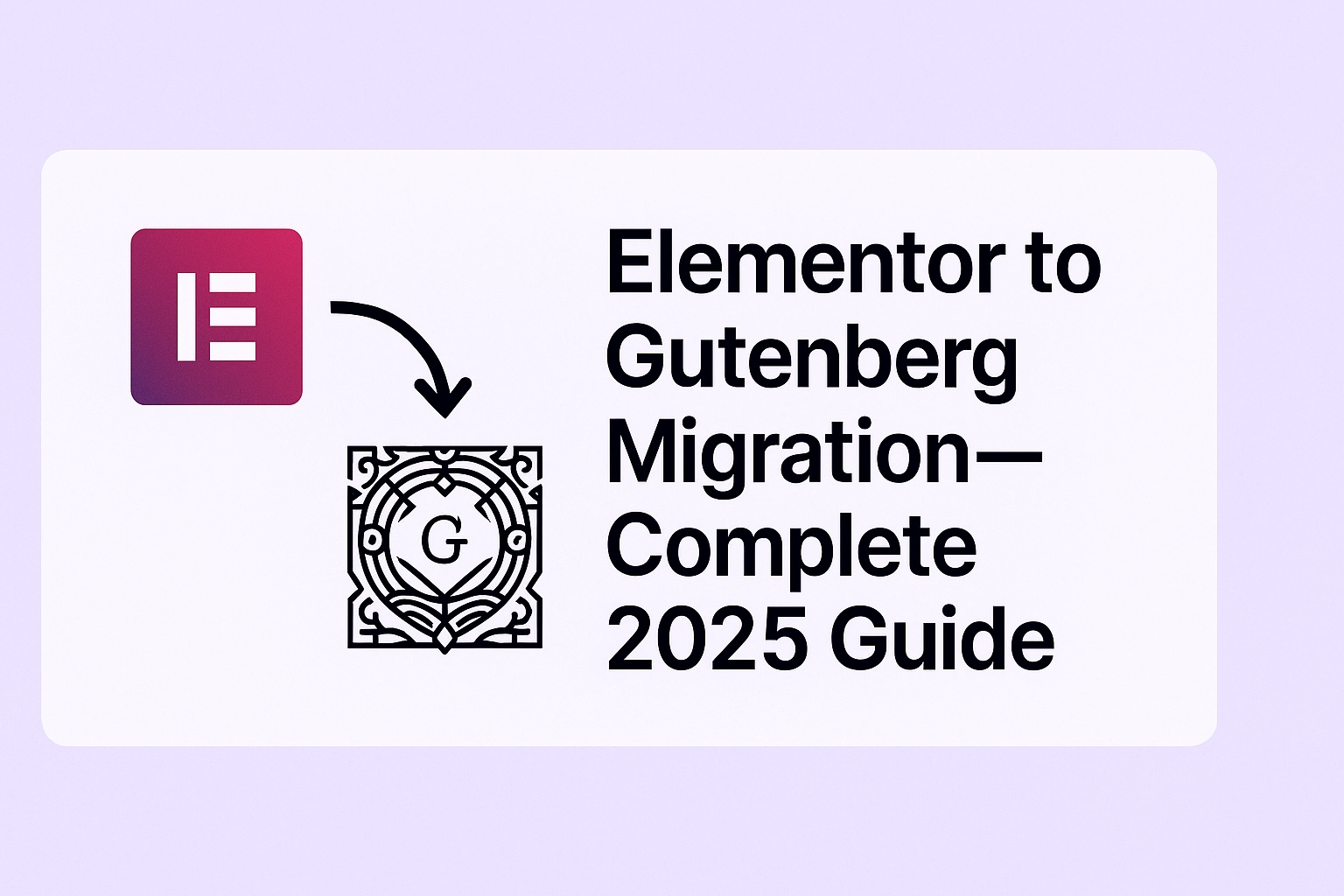Elementor to Gutenberg Migration – Complete 2025 Guide
This Gutenberg 2025 guide walks you through how to migrate from Elementor to Gutenberg without losing content or rankings. More businesses move to the native block editor for WordPress performance optimization, easier editing, and full compatibility with Full Site Editing (FSE). If you’re planning an Elementor -> Gutenberg conversion, use this step-by-step checklist, tested tools, and SEO safeguards.
As a WordPress Gutenberg development agency, we rebuild complex marketing sites and e‑commerce stores in Gutenberg and block themes. Start with a WordPress audit to estimate scope, risks, and the expected Core Web Vitals gains.
Table of Contents
Why move from Elementor to Gutenberg?
- Core Web Vitals improvements – Gutenberg outputs lighter, semantic HTML and ships fewer JS/CSS assets, helping LCP, INP, and CLS scores that Google recommends for Search success. See Google’s documentation.
- SEO-friendly structure – cleaner DOM, easier heading hierarchy, ALT text, and internal linking; simpler crawlability for bots. Learn more about the block editor on WordPress.org.
- Full Site Editing & block themes – design headers, footers, templates, and styles globally using Site Editor and Block Themes.
- Lower maintenance risk – fewer third‑party dependencies than a heavy page builder stack; better long‑term compatibility with core updates.
- Accessibility – core blocks include ARIA roles and keyboard navigation; easier to meet WCAG requirements.
Elementor vs Gutenberg — performance & SEO comparison
| Area | Elementor | Gutenberg |
|---|---|---|
| HTML / DOM | Deeper nesting and wrappers, extra containers | Lighter, semantic HTML; fewer wrappers |
| Assets | Multiple scripts/styles per page; extra payload | Lean core assets; load only what’s needed |
| Core Web Vitals | Often needs aggressive optimization | Better baseline for LCP/INP/CLS |
| SEO on‑page | More complex output to manage | Simpler structure; easier crawlability |
| Site‑wide editing | Theme builder features vary | Native FSE Site Editor & templates |
Migration steps: how to move from Elementor to Gutenberg
- Audit content and layouts – inventory pages built with Elementor, widgets, custom CSS/JS, and identify risky components. Use our WordPress audit to scope work.
- Pick a block theme (FSE) – to control headers, footers, templates, and global styles from one place. See Block Themes.
- Stage the migration – clone to staging; plan rollback and redirects; keep Search Console connected.
- Rebuild key templates – recreate sections with core blocks, Synced Patterns (formerly reusable blocks), and Query Loop for dynamic content.
- Preserve SEO parity – carry over titles, meta descriptions, H1–H3, ALT, schema, and internal links. Check sitemaps and canonical tags.
- Performance cleanup – remove leftover Elementor assets/tables; enable lazy loading (default since WP 5.5), minify/concatenate where helpful. Background: lazy‑loading in core.
- Accessibility testing – verify focus order, contrast, keyboard navigation; fix headings and landmark roles.
- Monitor after launch – track GSC Core Web Vitals report, PageSpeed Insights, logs, and rankings; iterate on LCP/INP/CLS.
Helpful tools & block resources
- Convert to Blocks – convert classic content to blocks (useful for legacy sections).
- Block Editor basics & developer handbook – official docs.
- Query Loop block – dynamic archives without code.
- Synced Patterns (Reusable Blocks) – maintain consistency at scale.
- Spectra Blocks – robust block library to replace common builder widgets.
FAQ.
Don’t see your question? Drop us a message. We’re always happy to help.
How does the migration affect SEO?
Done correctly, it’s positive. Maintain titles, meta, headings, ALT, schema, and internal links; the lighter markup typically improves crawlability and Web Vitals.
How long does an Elementor → Gutenberg migration take?
The timeline depends on the scope of your site and the level of customization involved. A smaller website with standard layouts can often be migrated within a few weeks, while larger projects with complex designs, custom widgets, or SEO-sensitive structures may take several months.
We always begin with a scoped audit and a staging plan. This allows us to identify potential risks, map content and functionality, and ensure SEO continuity. From there, the process involves careful preparation, detailed analysis, and custom coding to rebuild layouts in Gutenberg while maintaining performance and design fidelity.
Can I run Elementor and Gutenberg side by side?
Technically yes, but it increases payload, conflicts, and editorial overhead. For speed and consistency, move fully to the block editor.
What about plugin compatibility and custom widgets?
Most plugins are editor‑agnostic, but Elementor‑only widgets will need block equivalents or custom blocks. Use the move to reduce unnecessary plugins.
How do I protect SEO during the transition?
Keep URLs or map 301s, preserve metadata, headings, and structured data. After launch, check the Core Web Vitals report and fix regressions quickly.
How can I speed up templates after migrating?
Optimize hero images (WebP/AVIF), limit third‑party scripts, load assets conditionally, and use native lazy‑loading. See lazy‑load in WordPress 5.5+.
Does Gutenberg offer all Elementor features?
Not one‑to‑one, but the block ecosystem grows fast. With block libraries (e.g., Spectra) and custom patterns, most common layouts are covered—with lighter output.
Where can I learn more about the block editor?
Start with the Block Editor guide, the Developer Handbook, and the Site Editor docs.
Final thoughts
Migrating from Elementor to Gutenberg is a long‑term investment in performance, SEO, and maintainability. With block themes, FSE, and a focused optimization plan, teams publish faster and meet modern UX standards. Need help? Contact our Gutenberg experts.







